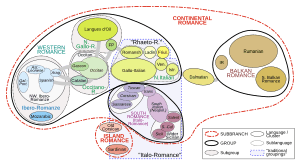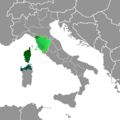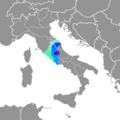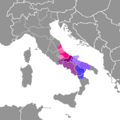Italo-Western languages facts for kids
Quick facts for kids Italo-Western |
|
|---|---|
| Geographic distribution: |
Italic Peninsula, France, Iberia (Spain and Portugal), Latin America, and parts of West Africa |
| Linguistic classification: | Indo-European |
| Subdivisions: | |
 |
|
The Italo-Western languages form the largest group within the Romance languages. These languages all grew from Latin, the language spoken by the ancient Romans. Today, Italo-Western languages are spoken by hundreds of millions of people around the world.
This big language family is split into two main branches: the Italo-Dalmatian languages and the Western Romance languages.
Contents
What are Italo-Western Languages?
Italo-Western languages are a major part of the Romance language family. Romance languages are those that developed from Vulgar Latin. This was the everyday Latin spoken by ordinary people in the Roman Empire. As the Roman Empire grew, Latin spread across Europe. Over time, different areas developed their own ways of speaking Latin. These differences eventually became new languages.
The Italo-Western group includes some of the most widely spoken languages today. These include Italian, French, Spanish, and Portuguese.
Where are These Languages Spoken?
These languages are mostly spoken in Europe, especially in Italy, France, Spain, and Portugal. However, because of history, they are also spoken in many other parts of the world.
For example, Spanish and Portuguese are the main languages in most of Latin America. French is spoken in parts of Canada, many countries in West Africa, and some islands in the Caribbean. Italian is also spoken by communities in various countries due to migration.
Two Main Families: Italo-Dalmatian
The Italo-Dalmatian branch mainly includes languages spoken in Italy. The most famous language in this group is Italian.
Languages of Italy
- Italian: This is the official language of Italy. It is based on the Tuscan dialect spoken in the region of Tuscany. Many people consider Tuscan Italian to be the most beautiful form of the language.
- Other Italian varieties: Besides standard Italian, there are many other dialects spoken across Italy. These include Neapolitan (spoken in Naples and southern Italy), Sicilian (spoken in Sicily), and Venetian (spoken in Veneto). Some of these are quite different from standard Italian.
- Dalmatian: This language was once spoken along the coast of Dalmatia (modern-day Croatia). Sadly, the last speaker of Dalmatian died in 1898, so it is now an extinct language.
Two Main Families: Western Romance
The Western Romance branch is the larger of the two groups. It includes languages spoken in France, Spain, Portugal, and many other countries. This branch is often divided into two smaller groups: Gallo-Romance and Ibero-Romance.
Languages of France
- French: This is the official language of France. It is also an official language in Belgium, Switzerland, Canada, and many African countries. French is one of the most studied languages in the world.
- Occitan: This language is spoken in southern France and parts of Italy and Spain. It has a rich history of poetry and literature.
- Franco-Provençal: Also known as Arpitan, this language is spoken in parts of France, Switzerland, and Italy.
Languages of Iberia
- Spanish: This is the official language of Spain. It is also the main language in most countries in Central and South America. Spanish is one of the most widely spoken languages globally.
- Portuguese: This is the official language of Portugal and Brazil. It is also spoken in several African countries like Angola and Mozambique.
- Catalan: Spoken in Catalonia (a region in Spain), Andorra, and parts of France and Italy. It is an official language in Catalonia and Andorra.
- Galician: Spoken in the Galicia region of Spain. It is closely related to Portuguese.
Why are These Languages Important?
The Italo-Western languages are important for several reasons:
- Global Communication: Languages like Spanish, French, and Portuguese are spoken by hundreds of millions of people worldwide. This makes them very useful for international communication, travel, and business.
- Cultural Richness: These languages are home to vast amounts of literature, music, art, and history. Learning about them helps us understand different cultures.
- Historical Links: They show us how languages change over time. They also connect us to the history of the Roman Empire and how its influence spread.
Studying Italo-Western languages helps us see how languages evolve and how they connect people across continents.
See also

Images for kids






